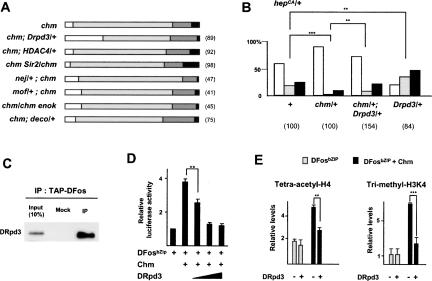Figure 6.
DRpd3 interacts with DFos and counteracts Chm function. (A) Genetic interactions of chm with HDAC- and HAT-encoding genes during thorax closure, revealed by the strength of the thoracic cleft phenotype. The numbers of examined pupae are given in parentheses. Refer to Figure 1A for the color code of phenotypic classes. (B) Changes in the distribution of the wing phenotype classes associated with hepCA (see Fig. 2A) by heterozygosis for Drpd304556 allele and suppression of the rescuing effect of chm heterozygosis. Refer to Figure 2A for the color code of phenotypic classes. (C) Western blots, revealed by anti-DRpd3, of immunoprecipitates obtained by anti-TAP from nuclear extracts of wild-type (Mock) and armGal4 UASTAP-Dfos/UASMyc-chm third instar larvae. (D) Luciferase assays of HEK293 cells transfected with DFosbZIP, Chm (250 ng/well), and increasing amounts of DRpd3 (50, 100, or 250 ng/well). Reference value of 1 for cells transfected with DFosbZIP alone; four independent assays. (E) ChIP of chromatin extracts from HEK293 cells transfected with DFosbZIP or DFosbZIP and Chm, in the presence or absence of DRpd3. Immunoprecipitations were performed with antibodies to tetra-acetylated H4 (left) and to trimethylated H3K4 (right). Data are represented as a relative levels compared with transfection with the reporter alone (average of three independent assays).

